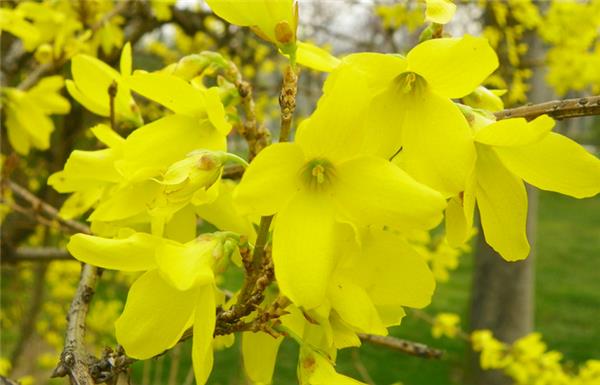[the difference between Flos Lonicerae and Forsythia suspensa] what is the difference between Flos Lonicerae and Forsythia suspensa
The golden bar of the golden bell flower is golden and brilliant, and can be planted in lawn, corner, roadside, tree edge, courtyard, and so on. The ornamental effect is very good, but the golden bell flower and Forsythia suspensa look similar. Let's enjoy the flower posture of the golden bell flower and learn the difference between the golden bell flower and Forsythia suspensa.

I. the difference between Flos Lonicerae and Forsythia suspensa
Fructus Forsythiae and Fructus Forsythiae are brothers of the same clan, which are mainly different in plant shape and color. The branches of the flower are erect, bell-shaped, golden or dark yellow; the branches of Forsythia suspensa are arched and pendulous, the pith is hollow, and the flowers are bell-shaped. Bright yellow. However, their hybrids are called Forsythia suspensa, with plants shaped like golden bell flowers, erect branches, flowers like forsythia and bright yellow. Let's take a look at the specific differences between Golden Bell Flower and Forsythia suspensa.
Branches: forsythia stem tufted, erect, branches spread, arched drooping, branchlets yellow-brown, pulp hollow; Admiralty branches erect, branchlets yellowish green, pulp thin sheet.
Flowers: forsythia is usually solitary, sparse 3 axillary, Corolla golden yellow, sepals as long as Corolla tube; Admiralty flowers 1 to 3 axillary, yellowish green, sepals as long as the middle of the Corolla tube.
Leaves: Forsythia suspensa is simple or sometimes 3-foliolate, opposite, leaf margin coarsely serrated; Admiralty single leaf opposite, coarsely serrated above the middle of the leaf.

Second, the upside-down culture of Golden Bell Flower
1. Soil: fertile, loose and well-drained culture soil should be used in pot upside-down Admiralty substrate. Generally, rotten leaf soil and Gaza loam soil can be evenly mixed with rotten organic fertilizer and phosphate fertilizer, without the need to apply base fertilizer to avoid rotting roots.
2. Watering: Admiralty should be watered upside down. You can spray water on branches and leaves twice a day in dry spring and hot summer seasons. Do not water too much to cause stagnant water in basin soil. If the room temperature is low in winter, watering should be strictly controlled and fertilization should be stopped to prevent rotting roots. Loosen the soil in time after each fertilization and watering to facilitate ventilation.
3. Sunshine: hang the golden bell upside down and like the shade, but this does not mean that it does not need sunshine. in addition to shading it in summer, other seasons should properly accept some warm sunshine.

Third, how to prune forsythia flowers
Forsythia flowers can be trimmed into various shapes, such as happy shape, bush shape, and so on. Here are two pruning methods:
1. Open heart shape: after the Forsythia suspensa flower is planted, when the forsythia flower is about 1 meter high, the top tip is cut off at 70 kilometers 80 meters above the ground in the trunk, and the heart is picked out in the summer to promote the growth of branches in different directions. Several well-developed lateral branches are selected and cultivated into the main branch. Through several years of shaping and pruning of Forsythia suspensa flower, it forms a natural happy tree shape of low dry crown, hollow and round, ventilated and transparent.
2. Thicket shape: it makes use of the strong sprouting ability of forsythia flower to cut and propagate. In the early spring of the second year of planting, the upper end of the plant was cut off 20 meters above the ground. When the temperature rises in spring, the roots of Forsythia suspensa begin to move, and the nutrients stored in the roots will be transported upwards. under the condition of increasing fertilizer and water management, forsythia branches grow very fast, and when they grow to about 25 meters, pick the terminal bud and make it produce secondary branches. More than 10 secondary branches can sprout from each primary branch. After ear harvesting, the third or fourth grade branches sprouted on the second stubble were collected.

Forsythia blossoms when the fragrance is light, brilliant yellow flowers are now very lovely, with a better ornamental value, Forsythia suspensa culture method told you, I hope to help you.
Related
- Wuhan Hospital Iron Tree Blooming Result Was Instantly Frightened by the Gardener Master
- Which variety of camellia is the most fragrant and best? Which one do you like best?
- What is the small blue coat, the breeding methods and matters needing attention of the succulent plant
- Dormancy time and maintenance management of succulent plants during dormancy
- Minas succulent how to raise, Minas succulent plant pictures
- What are the varieties of winter succulent plants
- How to raise succulent plants in twelve rolls? let's take a look at some experience of breeding twelve rolls.
- Attention should be paid to water control for succulent plants during dormant period (winter and summer)
- Watering experience of twelve rolls of succulent plants
- Techniques for fertilizing succulent plants. An article will let you know how to fertilize succulent plants.



